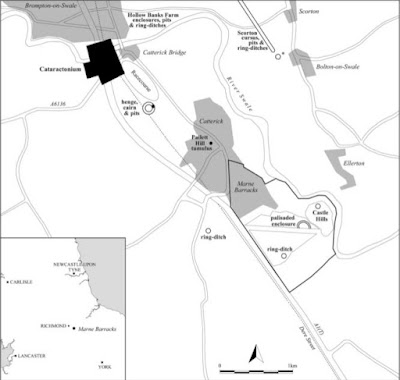The site of the famous Battle of Brunanburh has continued to elude scholars. [1] I would like to throw my hat in the ring with a new identification. [At least, I think it's new; I may not have found all there is out there that is recent on the subject!]
The best place to start is the excellent treatment of the place in this source:
There we learn that other than the variants for the name Brunanburh itself, we also find the Old Norse
Vinheidr (heidr = heath, i.e. place of heather) from EGIL'S SAGA, a Weondune or Wendune from Symeon of Durham and a Othlynn or Othlyn from the Annals of Clonmacnoise.
It did not take much of a map search for me to find Winton in North Yorkshire on the edge of North York Moors, i.e. heathland.
This town is on the edge of the North York Moors and is known for its scenic heather landscapes. Thus I would guess that Vinheidr is for Winton.
The Winton Beck joins the Brompton Beck under a kilometer from Brompton. Brompton is found early as Bruntun, etc.
A Roman road runs through Brompton and Winton.
While dun is the English word for hill, it could easily be confused with tun.
The puzzler is the Annals of Clonmacnoise's Plains of Othlynn or Othlyn. But, fortunately, I found this site:
After looking up in Rivet and Smith's THE PLACE-NAME OF ROMAN BRITAIN, I was able to confirm the otalini spelling for the Votadini. However, we are not talking about the ancient kingdom of the Votadini, which stretched from Edinburgh in the North to the eastern portion of Hadrian's Wall. Instead, this is an oblique reference to the Gododdin at Catterick. Brompton on Swale (Brunton) is on the opposite side of the River Swale from the Roman fort of Catterick.
Is this a problem? I don't think so.
The following is from Brittonic place-name expert Alan James (personal correspondence):
I'm not sure if you're aware of the lost Winton in Catterick parish? Specifically, somewhere near Colburn: Wintuneoves, Wintun houes, Wyntonhowes, all from 12th - early 13th ct, imply such a place, with 'howes' named from it - which may have been Norse haugar, burial mounds.
I'm not sure if you're aware of the lost Winton in Catterick parish? Specifically, somewhere near Colburn: Wintuneoves, Wintun houes, Wyntonhowes, all from 12th - early 13th ct, imply such a place, with 'howes' named from it - which may have been Norse haugar, burial mounds.
Smith, A. Hugh, (1928) The Place-Names of the North Riding of Yorkshire English Place-Name Survey Vol. V, Cambridge.
The place-name survives as Wintylow, now a farm (and for local government in Richmond district). It's mentioned in passing in this piece; that there are pits, possibly old coal-pits, in the vicinity is interesting, it seems to be a place with lots of humps and bumps!
The Howes of Winton
If we, then, accept all three names - Brunanburh, Wendune and Othlyn - we have a firm fix on the battle site. It would be at the Roman fort that lies between Brompton and Winton Howes.
This is my choice for Brunanburh. And it is quite a choice, as it would mean that the scene of a famous Dark Age battle between the British and the English was also the scene of a later, equally as famous battle.
[1]
From Alan James on the current thrust of research into this subject:
Finally, unfortunately, neither of us is likely to be able to access this new article by Clare Downham, but she's certainly an authority on the historical context, and generally very persuasive:
'There has been significant local publicity in the North-West relating to the search for the site of the Battle of Brunanburh. The purpose of this article is not to review recent metal detector findings, but to explore why the Wirral would have made strategic sense as the location for the conflict. To contextualise the discussion, brief consideration is given to the historical events surrounding the battle, the development of narratives about the conflict (including the claim that it took place near the River Humber), and the place-name evidence. It should be noted that many different locations have been put forward for the battle site, and no doubt arguments for alternative locations will continue. However, consideration of geographical factors as well as linguistic and historical evidence make a strong case that this conflict took place in the Wirral and in the vicinity of present-day Bromborough.'
Wirral Archaeology also thinks Brunanburh should be Bromborough. They have launched a good Website which covers their work on the site:
However, Bromborough does not explain either the Wendune of Simeon of Durham, nor the Othlyn Plains of the Clonmacnoise Annals.







No comments:
Post a Comment
Note: Only a member of this blog may post a comment.